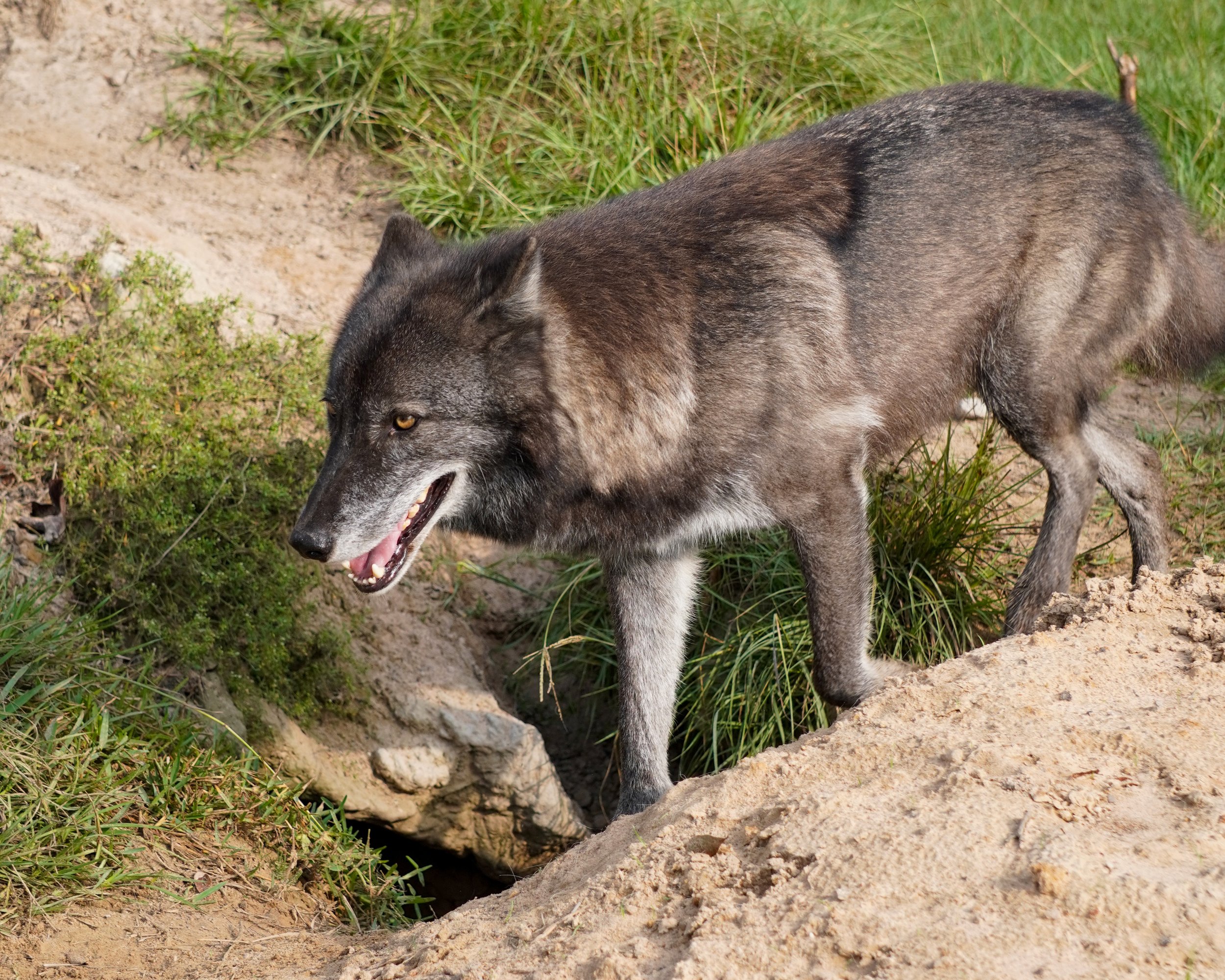
FAQ: CONSERVATION
FAQs: CONSERVATION
-
As of February of 2022, gray wolves have been re-listed on the Endangered Species List. Under the Endangered Species Act, no person may hunt, kill, trap, injure, pursue, harm, or harass any listed species. As of 2020 there were only about 7,500 wolves left in the lower 48 states, although including Alaska their population is closer to 15,000. This makes hunting and trapping wolves in most states illegal.
The only areas in the U.S. that are not managed under the federal government are Alaska, where the wolf population is considered stable, and the Northern Rockies. These states, which include Wyoming, Idaho, and Montana, manage at the state’s discretion. All of these states still allow wolf hunting and trapping, although the wolf populations in the area are rapidly deteriorating. According to National Geographic, in 2021, 500 out of 2,600 wolves were eradicated during that hunting season— that’s almost 20% of the population!
Red wolves remain critically endangered since 1967. As of June 2023, the population estimate of wild red wolves is 25 individuals.
The worldwide gray wolf population remains stable, but the red wolf is native only to North America, and thus is in critical danger.
-
While some human cultures have tolerated or even venerated wolves, for millennia these animals have been viewed by many as vicious, bloodthirsty devils incarnate, a threat to “civilization.” One reason is that they have long had a reputation as being dangerous to people, but this danger has been wildly exaggerated (see below). Another big reason is that wolves sometimes attack livestock—though the threat they pose to livestock has also been exaggerated (see below)—and so many people, especially ranchers and others living in rural areas, still view wolves as cruel, bloodthirsty killers. Another group that frequently demonizes wolves is game hunting enthusiasts. While most big game hunters are reasonable people who love the outdoors and support intelligent and responsible wildlife management, there are also unfortunately many others who are concerned only with bagging as many trophies as possible. So despite the fact that predators like wolves play an important role in regulating and maintaining the health of their ecosystems, there are many people who would like to see wolves eliminated because the short-term result will be larger populations of game like elk and deer, or because they consider wolves “savage killers”. Most of the wolf’s nasty reputation derives from prejudice, misinformation, and fairy tales like “Little Red Riding Hood,” rather than from reality.
-
Evidence shows that wolves prefer to hunt their natural prey when that prey is abundant, but in large areas throughout the world, wolves’ original habitat has been destroyed and their wild prey eliminated to make way for farms, pastures, and cities. As a result, wolves in some parts of the world do regularly hunt livestock, and have evidently been doing so for a long time. But while it’s true that wolves sometimes attack livestock, especially where their natural prey is gone, the threat they pose to livestock in the U.S. is negligible. Generally, wolf predation accounts for less than 3% of livestock mortality in the states where they occur, but many ranchers are so used to the negative stereotypes attached to wolves that they are quick to blame them whenever deaths occur. For instance, in 1991, U.S. cattle ranchers reported 1,400 losses to wolves; of these, 1,200 occurred in states where wolves did not live! The truth is that coyotes and domestic dogs pose a far greater threat to livestock in the U.S. than wolves do. Nonetheless, ranchers’ fears are not entirely groundless, and we need to be honest in admitting that wolves will sometimes attack livestock if presented with the opportunity, and there should be systems in place to compensate or protect ranchers who experience losses. However, we would urge that non-lethal deterrents be used whenever possible, and that ranchers come to view wolves as an important part of the environment, even if it is a part which occasionally comes into conflict with us.
-
The short answer is: usually not. Wolves are very shy and reclusive, and their normal reaction to people is extreme fear, rather than aggression. Especially in North America, cases of healthy wolves attacking people are extremely rare. Historical cases of wolf attacks can usually be attributed to rabies or other illness, wolfdogs or wolves that had been habituated to people, or just an overactive imagination. To put the threat posed by wolves in perspective, a person in wolf country has a greater chance of dying from lightning or a bee sting than they do of being attacked by a wolf. Nevertheless, people in wolf country should take basic precautionary measures: leave food and trash in sealed containers, never feed wolves or other wild animals, never leave children unattended in lowly-populated areas, don’t allow pets to wander free, try to travel in groups when possible, etc. If you are confronted by a wolf, never run from it, as that will trigger its prey drive—instead, try to make yourself appear as big as possible, make loud noises, wave your hands, and try to scare it off, while backing slowly away.
-
Before they were persecuted by people, grey wolves were the most widespread of all wild land mammals, living from central Mexico to the Canadian high arctic islands and from southern India and North Africa to Siberia. They lived in a wide variety of habitats, from deserts to forests to prairies to steppes to mountains to taiga to tundra. Today, wolves mostly live in remaining wilderness areas like much of Canada or national parks like Yellowstone, but there are also some wolf populations living near populated areas, especially in parts of Europe and the Middle East. In the U.S., grey wolves are found in Alaska, California, Idaho, Michigan, Minnesota, Montana, Oregon, Washington, Wisconsin, and Wyoming. There is also a small population of Mexican grey wolves that was released into Arizona and New Mexico, and a small population of red wolves that was released into North Carolina. Elsewhere in the world, grey wolves can be found in North Africa, parts of India, the Middle East, parts of China, the steppes of central Asia, Turkey, Russia, Scandinavia, and several areas of southern, eastern, and central Europe.
-
While both red and grey wolves once lived in this state, there is no longer any wild wolf population in Texas, although it’s possible there may be occasional grey wolves present which are escaped captive animals. Grey wolves were essentially extirpated from the state by the 1940s. Red wolves once lived throughout the eastern half of the state, but they were mostly eliminated early in the 20th century as well, and by the 1970s the few remaining red wolves were captured by the federal government for use in a captive breeding and reintroduction program. People often report seeing wolves in Texas, but the most likely explanation is that the animals are escaped captive animals, misidentified dogs or wolfdogs, or larger than average coyotes (some Texas coyotes appear to have some red wolf DNA due to past interbreeding, and appear more wolf-like than normal coyotes). Zoologist David Schmidly writes in The Mammals of Texas: “A few reports are received each year concerning the occurrence of red and grey wolves in Texas; however, in those instances where it has been possible to study the specimen, all have proven to be unusually large coyotes.”
-
There are two wolf species living in America: the grey wolf (Canis lupus) and the red wolf (Canis rufus). There are five subspecies of grey wolf in North America: the arctic wolf (Canis lupus arctos), eastern timber wolf (C. l. lycaon), Great Plains wolf (C. l. nubilus), Mexican wolf (C. l. baileyi), and Rocky Mountain wolf (C. l. occidentalis). Of these species and subspecies, the red wolf and Mexican wolf are critically endangered, with only a few hundred individuals of each remaining.
-
Aside from continued direct persecution by people, the most significant long-term threat to wolf conservation is habitat destruction. The world’s human population continues to grow tremendously, and we continue to destroy huge tracts of wild land in order to house ourselves, obtain natural resources, and create spaces for farming and ranching. Continued destruction of the wolf’s natural habitat and prey base will both drive it to a more marginal existence, as well as bring it into greater conflict with people. Some of this habitat destruction is unavoidable, but much of it is due to unsustainable levels of resource and land usage, particularly in the developed world.
-
There are a number of simple steps you can take to help wolves. Some of our suggestions include:
- Advocate: Write letters to or call your elected representatives and appropriate government agencies and tell them your positions on wolves and other conservation issues. Contact representatives who support wolf hunting and tell them your position. Write to newspapers or other media outlets too. Always make sure your communications are polite, respectful, well-reasoned, and well-supported by the facts.
- Change minds and educate: If you have friends or family who are opposed to wolf conservation efforts or view wolves as evil and bloodthirsty, help educate them and politely try to show them the truth about wolves.
- Reduce, reuse, and recycle: Habitat destruction, human overuse of non-renewable resources, climate change, and similar problems form the greatest future conservation threat that wolves will face. You can play a role in fighting this threat by reducing your own consumption of nonrenewable resources, and buying products produced responsibly and sustainably. Consider also eating less meat, which is far more expensive to produce in terms of land use and carbon footprint. Buy locally-produced food and other products when you can.
- Volunteer and donate: Give time, money, support, and/or other needed resources to organizations which support wolves, other endangered animals/ecosystems, conservation, and education.
